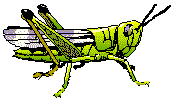|
In a 'Z' shaped area from Oregon to Dakota to Kansas to Missouri these clouds began to descend upon the land. Reports of "lakes" of grasshoppers 3 inches deep were not uncommon. Branches of trees broke under their weight. Farmers, like Charles, tried to save their crops by setting fire to straw and dung, but all attempts were futile. The grasshoppers were starving and fighting to find every scrap of food. Families covered their vegetable plots with sheets and cloths only to find the grasshoppers eating the sheets. The grasshoppers were so hungry they were eating human clothing, hair and skin. They were even eating each other. Every piece of living vegetable matter was eaten, leaving nothing for the farmers to collect for the winter. Even the animals left, looking for something to eat.
|
|
Some farmers, disillusioned, packed their belongings into their wagon and headed back east. In disgust, they painted pictures of grasshoppers on the side of their wagons to show everyone why they were leaving. In order to help those who stayed, the federal government offered relief to farmers, but it quickly ran out. In some states money was offered to those who killed the grasshoppers. In Minnesota, people could make 50 cents for every bushel of grasshoppers collected. (A sack with a diameter of 12 inches (30cm) and 15 inches (38cm) high). So many grasshoppers were collected in that state, it went bankrupt. 1874 was a very difficult winter, and the grasshoppers came back in 1875, but eventually the numbers decreased back to normal levels.
|
|
It is not fully known why the grasshoppers should have chosen to swarm in such great numbers that year. The previous winter had been very mild and this would have allowed the grasshoppers to mature much earlier. Also the clearing of land for agriculture may have encouraged the grasshopper, who normally lives in arid and bare areas to move out into the dry, cleared farmland. Having bred so successfully and early that year they had to move in such great numbers in order to find food and new places to lay their eggs.
|
|
Ref.
Brown, D., The American West. (1995);
Chapman, R.F., Biology of Grasshoppers, (1990);
Otte, D., The North American Grasshoppers, (1981);
|

